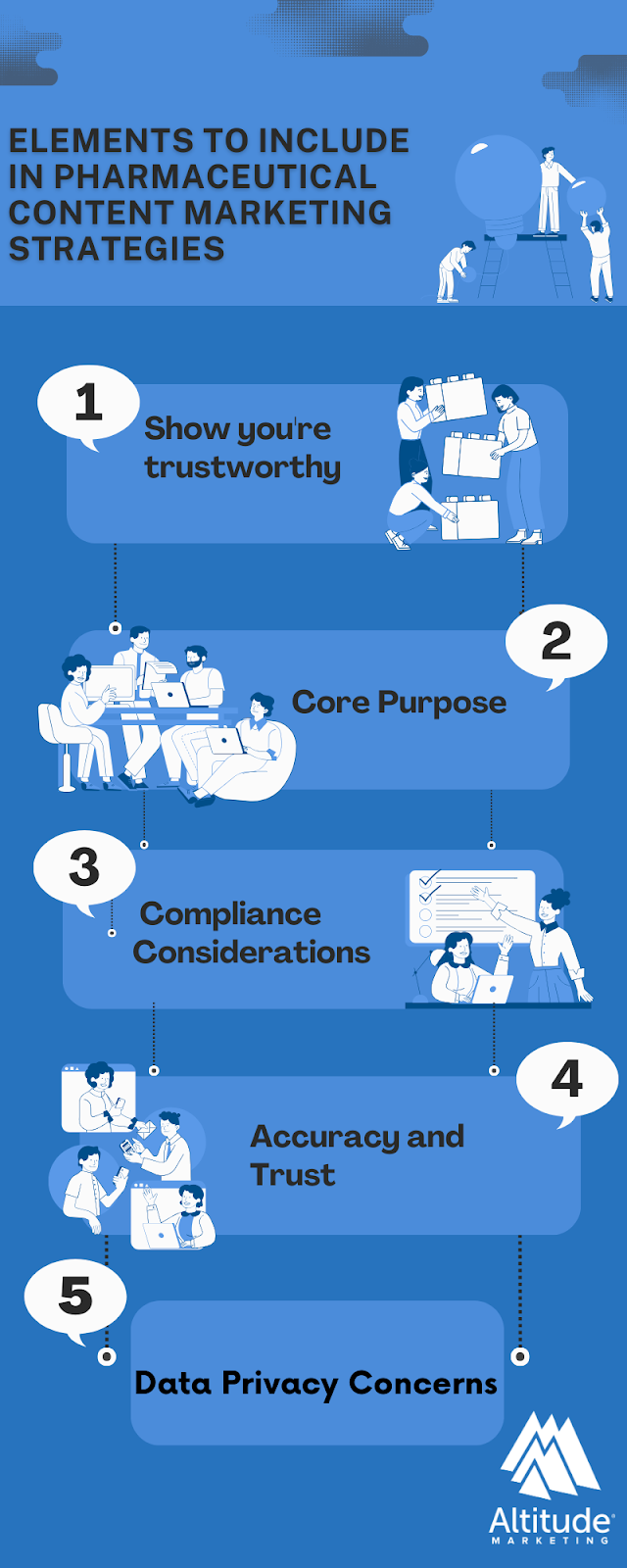Content marketing means creating and sharing compelling stories, advice, and services to get people’s attention. For B2B organizations in the pharma industry, that means producing elements like emails, blogs, white papers, and longform articles that target your customers. The goal is to give helpful, educational information. This helps raise awareness, boost engagement, and build loyalty. With an expanding market cap of nearly 500 billion dollars by 2028, the industry is ripe for growth. But getting a piece of the expanding pie requires content that makes your brand stand out.
Pharmaceutical B2B content needs to be accurate and trustworthy. 83% of marketers say it’s better to focus on quality rather than quantity of content, even if it means posting less often. With so much misinformation online, brands need to cut through the noise with detail, accuracy, and engagement. That means having scientific facts checked by professionals. It also means avoiding hype and being honest when something isn’t fully proven yet. At the end of the day, the content you produce needs to help people live healthier, happier lives. If it educates and empowers prospects and providers, while also sharing the brand’s expertise, then it has succeeded.
In this blog, we will explore ways to build a results-driven content strategy specific to a pharmaceutical audience.

6 Content Marketing Tips for the Life Sciences
What is Pharmaceutical Content Marketing?
Whether it’s blogs, white papers, long-form articles, email newsletters, or social media posts, content marketing encompasses your brand’s ability to share what it does and why it does it. You’re building a narrative that targets the right audience, ensuring they know you are exerting yourself at what they do. For B2B pharmaceutical companies, this means targeting other businesses in your field. You aren’t going after prospects, but rather aiming for companies that want to use your service.
To make successful, compliant marketing materials, pharma companies should build a strategy using top-notch content. This content should teach clients about your service.
Content marketing is powerful. It helps target and engage people with reliable, far-reaching, real content. It helps earn trust and loyalty by speaking to what matters to prospects.
When producing content, you should:
- Use simple words that are understandable to the target audience
- Break into shorter sentences
- Include real-time examples
- Take a conversational tone such that it engages the reader
Connecting with the target audience helps pharma brands build connections and share knowledge.
The key is explaining concepts clearly and avoiding jargon. Bring your complex work out of textbooks and into the real world. This ensures your narrative truly resonates.
Elements to Consider in Pharmaceutical Content Marketing
When building your content marketing strategy, there a few things you should consider.

1. Show you’re trustworthy
People sometimes feel like pharma brands just want money. With so much online, it’s hard to know what’s true. Studies show that 23% of Americans share fake news without knowing. This leaves people confused about facts. Objective content helps people make smart choices by cutting through the noise.
Content marketing has become a pivotal strategy across most industries today, enabling brands to educate and engage their target audiences. However, while the fundamentals remain the same, the pharmaceutical space does have some unique aspects compared to other sectors.
2. Core Purpose
At its essence, content marketing refers to creating and distributing valuable, relevant, and consistent content to attract and retain a clearly defined audience. Whether in pharmaceuticals, technology, finance, or retail, the end goals include driving brand awareness, establishing thought leadership, generating leads, and building trust and loyalty.
The core purpose remains engaging users with informational and story-driven content that keeps the brand top-of-mind. This allows companies across sectors to nurture prospects.
3. Compliance Considerations
However, the heavily regulated nature of the pharmaceutical and healthcare industries requires certain restrictions around promotional content and advertising that other sectors do not face. There are stringent rules governing what pharma brands can and cannot say about their products, especially related claims about safety and efficacy.
As such, their content strategy needs more caution about remaining compliant and transparent. Any perceived overreach or misleading claims can easily lead to severe penalties. Hence, pharma content requires extra diligence around adhering to industry regulations.
4. Accuracy and Trust
Additionally, the stakes involved in healthcare mean that content accuracy and trust are paramount for Pharma brands. As opposed to fashion or even tech brands, your customers relate to drug-makers at a more sensitive, personal level with their clients’ health at stake.
This means pharma content cannot afford any gray areas or misinformation, both ethically and legally. Maintaining scientific rigor and clinical validity is vital for content credibility.
5. Data Privacy Concerns
Relatedly, pharmaceutical content requires a heightened focus on privacy and security to maintain user trust. Other industries like retail and finance also deal with significant user data but health-related information is far more confidential and delicate for obvious reasons.
Any real or perceived breach of consumer data privacy can entirely erode a drug brand’s reputation. So data protection must be baked into the strategy from the start.
Enhancing Connections
That said, the core benefits that make content marketing useful for other industries still apply to the pharmaceutical space. Storytelling centered on the user journey helps pharma brands convey empathy and understanding of users’ problems to build authentic connections, much like lifestyle brands.
Likewise, an educational approach to disseminating content helps position them as thought leaders rather than pure sales channels. Content formats like visual aids, infographics, and videos can make complex information more accessible to lay audiences outside your area of expertise.
While adhering to compliance guidelines, pharma content needs creative flair for captivating, just like any other brand. Ultimately, the idea is to understand prospects and provide helpful solutions through quality content.
- Similarities: Both pharmaceutical and non-pharmaceutical companies use content marketing to reach their target audience. This enables them to provide valuable information and engage with prospects.
- Differences: The pharmaceutical industry has specific regulatory requirements and compliance guidelines. These must be adhered to when creating and sharing content with target audiences.
The information must be credible, thoroughly fact-checked, and compliant with industry regulations. In addition, the pharmaceutical industry uses unique content formats, like eDetailers and web portals for HCPs. This may not be as common in other industries.
Pharmaceutical content marketing shares similarities with content marketing in other industries. But it also has its unique challenges and opportunities. By understanding the pharmaceutical content marketing landscape, companies can better tailor their strategies to reach and engage with their target audience.
Key Considerations for Pharmaceutical Content Marketing
The pharma industry has some unique things to think about with content marketing. Let’s look at a few key points:
- Medical products have a lot of rules and regulations to follow. Content needs to go through strict checks and approvals. It must be precise, proven, and compliant. Thus, content in the industry has to follow many industry-specific laws.
- Ethics matter a lot in Pharma content. Marketers must make sure the information is accurate and honest. It should give a balanced view, not hype things up. Don’t mislead people or leave out key details. Upholding ethics builds trust.
- Connect with both hearts and minds. Share inspiring stories that make the content relatable. Back it up with solid medical facts. Blend emotion with credible science for impact.
- Update content to educate on new treatments and research. This shows the brand is an authority people can rely on. It also builds awareness.
- Medicine content should empower people to take charge of their health. Explain conditions and treatments in everyday language. Make it actionable so prospects feel equipped with knowledge. Don’t just sell –provide tools to live better.
Target Audiences in the Pharmaceutical Industry
- Businesses that Employ Healthcare Professionals: Content marketing in this industry targets healthcare professionals. It gives them valuable and educational information about products and treatments.
- Businesses that Empoy Caregivers: Pharmaceutical content marketing also aims to educate and inform prospects. The content is often about the various health conditions, treatments, and managing side effects.
- Investors and stakeholders: In addition to HCPs, pharmaceutical content marketing may also target investors and stakeholders. This aims to communicate the value and potential of pharmaceutical products and innovations.
| Target Audience | Tailored Content Types | Age Groups |
| Healthcare professionals (HCPs) | Clinical trial results, medical conference presentations, scientific publications, continuing medical education (CME) | 25-65 |
| Prospects | Prospects education materials, instructional videos, social media groups, forums | All ages |
| Investors and stakeholders | Financial reports, press releases, annual reports, shareholder presentations | 25-65 |
| Pharmacy staff | Product training, dispensing instructions, safety information | 20-65 |
| Payers (insurance companies) | Clinical and economic data, pricing proposals, formulary submissions | 30-65 |
| Employers/Corporate buyers | Plan design proposals, value demonstrations | 30-65 |
| Policymakers | Policy white papers, lobbying materials, political contributions | 40-75 |
| Students and recent graduates | Internship/job postings, recruitment branding content | 18-30 |
Content Formats and Channels
In pharmaceutical content marketing, content formats and channels are employed to establish meaningful connections with the target audience. This diversity allows for a multifaceted approach that caters to the varying preferences and needs of healthcare professionals and stakeholders within the pharmaceutical industry.
Articles
Detailed pieces on websites, journals, or reputable platforms share scientific research, breakthroughs, and information.
Conferences
Companies actively join physical and virtual conferences to share knowledge, showcase products, and connect with professionals.
Videos
From educational animations to expert interviews, videos visually convey complex information, creating a deeper connection.
Blog Posts
An effective means for pharma brands to share the latest insights, product updates, and thought leadership pieces. Blog content fosters two-way communication between drug makers and their communities through comments. They allow brands to address concerns transparently while conveying their commitment to prospects.
Quizzes
Interactive quizzes present an entertaining way for pharma companies to make scientific information more engaging and memorable. Well-designed quizzes speak to users’ intrinsic motivations for accomplishment and satisfaction from problem-solving. Presenting content through games and challenges incentivizes learning behaviors.
Podcasts
16 million people in the US are avid podcast fans. This audio format helps make in-depth, discussions around complex healthcare topics accessible to professionals and everyday buyers alike. For example, expert interviews explore the challenges of rare diseases or analyze policies governing prescription drug prices. Podcasts build thought leadership through value-driven conversations.
Webinars
Interactive web seminars enable pharmaceutical brands to conduct product demonstrations, deliver presentations, host panel discussions, and even provide compliance training to employees. The live format allows attendees to engage directly with subject matter experts through polls, surveys, and live Q&As to foster organic connections.
Metrics and Meaurements
To accurately determine the return on investment from content marketing and optimize future strategies, pharma brands need to implement robust metrics and analytics approaches. Performance indicators help quantify content effectiveness in achieving organizational KPIs:
ROI and Performance Metrics
ROI studies help quantify the revenue directly attributed to specific content campaigns compared to costs of production and distribution. Common performance metrics examine website traffic, audience engagement rates, lead generation, and sales figures influenced by content outputs. Together, these indicate how well branding objectives align with audience needs.
Tools and Techniques for Tracking
Advanced analytics platforms provide granular insights into content engagement and audience demographics. These tools enable data-backed refinements of outreach approaches:
Analytics Platforms
Solutions like Google Analytics, Adobe Analytics, and pharma-specific systems with privacy compliance offer detailed breakdowns of interaction metrics. These include visitor demographics, session durations, content downloads, referral sources, popular site pages, and conversion analysis.
A/B Testing
77% of companies are running A/B testing on their website. Split testing different versions of the same content piece allows pharma marketers to optimize elements like headlines, imagery, calls-to-action, and layouts. Tests reveal which variant receives higher click-through rates to drive further personalization.
CRM Systems
Customer relationship management systems centralize engagement data with healthcare professionals, patient support groups, and other key partners. They provide visibility into relationship stages, content preferences, and overall brand sentiment across stakeholder groups to nurture connections.
Strategies for Effective Content Marketing
Creating content in quantity is one thing, but creating content of high value is another. Here are some strategies pharma companies can follow when implementing their content marketing plan:
Data-Drive Content Creation
An evidence-based approach to developing content heightens relevance, accuracy, and personalization – critical for an industry dealing with consumer health and trust. This includes:
- Accuracy and Relevance: Pharma content must reflect the latest scientific advancements and disease mechanisms using credible empirical sources. Carefully vetted, up-to-date data ensures accuracy to build authority and reliability, especially amidst rampant health misinformation.
- Tailored Content: Analytics provides reader psychographics and consumption preferences to allow personalized content catering to specific learning requirements across audience subgroups. Such customization targets the right information to the right segments.
Market Research & Analysis
Curating individualized content pathways encourages self-directed learning while segmentedmessaging conveys context-specific ideas to each group:
- Individualized Content: Leverage reader history and journey analytics to recommend relevant articles, podcasts, expert videos, and other content tailored to displayed interests. Personalized nudges foster loyalty through perceived exclusivity.
- Segmented Messaging: Categorize target groups like healthcare professionals and caregivers through specialty, seniority, language preferences, and consumed formats. Then develop content optimized to resonate with segment-specific motivations and concerns.
Storytelling and Engagement
Leveraging narratives makes scientific content more compelling while focused retention strategies keep audiences hooked:
- Humanizing Complex Information: Patient vignettes, before-after case studies, and story arcs translate cold hard data into relatable experiences. Putting a human face to statistics for conditions under clinical trials, for instance, builds connections.
- Engagement Techniques: Pharma content requires acutely focused retention techniques like spare writing with signposted sections, graphic abstracts outlining key takeaways upfront, embedded quizzes, and interactive calculators. These break the monotony and renew attention.
Collaboration and Partnerships
Strategic co-creation alliances tap into specialized partner audiences while boosting content credibility:
- Healthcare Professionals: Collaborating with medical faculties and research clusters provides a direct conduit to world-renowned thought leaders as contributors or peer reviewers. Their subject focus sharpens content quality and clinical accuracy.
- Patient Advocacy: Partnerships with non-profits amplify patient voices missing from conventional literature. Their raw perspectives enlighten pharma writers on concerns often overlooked in purely clinical discussions.
- Influencer Marketing: Associations with prominent voices in digital healthcare sustain engagement beyond branded channels. Medical key opinion leaders and non-traditional science influencers lend their authenticity to enhance relatability.
Leveraging New Technologies
Advanced innovations boost content interactivity, personalization, and distribution:
- AI and Automation: Natural language algorithms generate content outlines automatically from technical documents. They also customize messaging for microsegments and publish updates across platforms. This efficiency and consistency free up human creativity for core strategy.
- Virtual Reality (VR): Immersive 3D experiences transport audiences into complex molecular interactions, clinical trial settings, and the patient journey under treatment. Visual storytelling through VR helps comprehension and emotional investment.
Some Global Considerations
While core topics remain consistent globally, some tactics require localization:
Regional Adaptations
Although disease mechanisms persist across geographies, terminology preferences, cultural contexts, and local regulations necessitate content tailoring regionally. Brand values shine through with cultural nuance.
Current Events
Global pharmaceutical content strategies need agility to address rapidly changing scenarios like pandemic outbreaks. Having processes to quickly develop in-depth explainers around emerging diseases or misinformation establishes helpful thought leadership.
The future of pharmaceutical content will likely see increased usage of:
- Real Global Stories: Content showcasing inspirational patient narratives and celebrating scientific breakthroughs makes for helpful storytelling full of teachable moments. This requires balance with data-proven facts.
- Emerging Technologies: Content showcasing inspirational patient narratives and celebrating scientific breakthroughs makes for helpful storytelling full of teachable moments. This requires balance with data-proven facts.
FAQs
Why is creating content about new medicines tricky for pharma companies?
Explaining the latest innovations can be challenging. The science behind how new drugs work through complex biological pathways involves many molecular interactions. Describe the mechanics while being clear and straightforward so fellow researchers fully understand. It’s a balancing act to get right.
Are other pharma companies even interested in content about potential new treatments?
In this fast-paced industry, every firm wants the inside scoop on promising compounds other teams are developing. If we present the science without overly technical language, it piques their interest. Content that compellingly relays the key facts gets readers excited about the possibilities.
What techniques make content about new medicines resonate?
Using simple words and short sentences prevents posts from feeling dense. Including analogies to things people know makes science less abstract. Adding visuals like diagrams and infographics to map out drug mechanisms helps too. With the right approach, we can unfold intricate concepts into a compelling story. The goal is to spark that moment of clarity for the reader.
Closing Thoughts
Pharma companies aim to meaningfully educate prospects about treatment options to build transparency and trust. However, given the scientific complexity and regulated nature of drugs, effectively simplifying information into accessible content remains an ongoing challenge.
This specialized domain limits the direct applicability of generalized best practices around content formats. Buyers seek content that blends compliance with a conversational human voice and memorable storytelling. Hence it becomes imperative for pharma businesses to collaborate with experienced healthcare content specialists equipped to strike this balance accurately.
In essence, content demands an approach that stays authoritative in tone yet relatable in style by aligning clinical validity with real-world considerations.
We help leading business-to-business brands hit their marketing goals. Get in touch to learn how Altitude Marketing can help you reach your peak performance.



